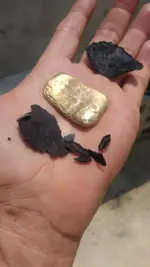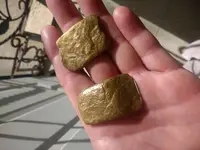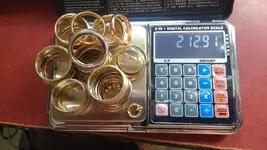BenjaminE
Full Member
- Joined
- Jun 2, 2014
- Messages
- 167
- Reaction score
- 243
- Golden Thread
- 0
- Primary Interest:
- All Treasure Hunting
I am a long time lurker. Also, I am an underwater metal detectorist, primarily.
I found two ingots in the Mexican Caribbean, at the bottom of potholes, in chest deep water. I discovered the ingots several hundred meters apart, in different potholes in an area where there does not seem to be any other metal.
When I found the first ingot, I could not flip it out of the hole with my spade, due to weight. It weighs around 38 grams. I finally reached into the bottom of the hole, and picked up what I thought was a rectangular lead fishing weight. When I pulled it out, I discovered that the object was coated with a black substance, that had small bits of shell embedded in it. When I turned the object over in my hand, I saw that one corner was shiny yellow.
I packed the object into my bag, and went home because the yellow metal had my attention. When I got home, I found that the "black substance" was actually something like a thin skin, or shell, that basically slipped off when I pulled on it.
The object is rectangular, but the ends are tapered. Both objects somewhat resemble "axeheads", or buckles. There is a tiny indentation, or crease, in one end as though the object was created in a mold.
I found a second similar ingot just a few weeks ago, as previously mentioned. The second ingot weighs just a few grams less, and is basically the same shape.
I have an old Whites XLT detector. And, the ingots ring up at between 69 and 80 on the XLT. I also had them tested for gold content, though the test only covers 8k and above. If they contain gold, it is less than 8k. Both times when testing, the testers commented they thought that the ingots contained gold, though not enough to test.
Also, the difference between these ingots, and regular brass artifacts, is that brass is generally somewhat porous, and develops corrosion, or becomes oxidized. These ingots, on the other hand, came out of deep potholes in the ocean, basically clean. They appear to be impervious to corrosion. There are no noticeable markings. And, they are extremely smooth to the touch, and do not appear to be porous at all.
I am tentatively guessing that they might be "tumbaga" ingots from before the arrival of the Spanish. But, maybe they are some sort of brass ingots?
Any serious input or suggestions would be greatly appreciated.


I found two ingots in the Mexican Caribbean, at the bottom of potholes, in chest deep water. I discovered the ingots several hundred meters apart, in different potholes in an area where there does not seem to be any other metal.
When I found the first ingot, I could not flip it out of the hole with my spade, due to weight. It weighs around 38 grams. I finally reached into the bottom of the hole, and picked up what I thought was a rectangular lead fishing weight. When I pulled it out, I discovered that the object was coated with a black substance, that had small bits of shell embedded in it. When I turned the object over in my hand, I saw that one corner was shiny yellow.
I packed the object into my bag, and went home because the yellow metal had my attention. When I got home, I found that the "black substance" was actually something like a thin skin, or shell, that basically slipped off when I pulled on it.
The object is rectangular, but the ends are tapered. Both objects somewhat resemble "axeheads", or buckles. There is a tiny indentation, or crease, in one end as though the object was created in a mold.
I found a second similar ingot just a few weeks ago, as previously mentioned. The second ingot weighs just a few grams less, and is basically the same shape.
I have an old Whites XLT detector. And, the ingots ring up at between 69 and 80 on the XLT. I also had them tested for gold content, though the test only covers 8k and above. If they contain gold, it is less than 8k. Both times when testing, the testers commented they thought that the ingots contained gold, though not enough to test.
Also, the difference between these ingots, and regular brass artifacts, is that brass is generally somewhat porous, and develops corrosion, or becomes oxidized. These ingots, on the other hand, came out of deep potholes in the ocean, basically clean. They appear to be impervious to corrosion. There are no noticeable markings. And, they are extremely smooth to the touch, and do not appear to be porous at all.
I am tentatively guessing that they might be "tumbaga" ingots from before the arrival of the Spanish. But, maybe they are some sort of brass ingots?
Any serious input or suggestions would be greatly appreciated.


Amazon Forum Fav 👍
Upvote
7




